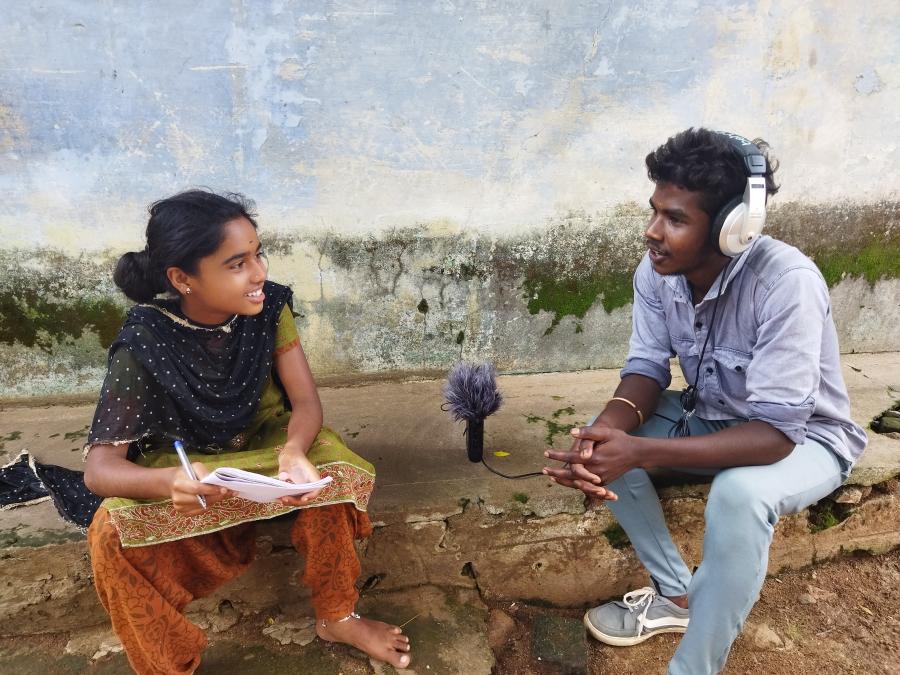The plight of landless agricultural labores
Thanka is a 55 to 60 year old widow. In the late 1960s and early 1970s she helped her village to unionize, and even became famous locally for having lain down in front of a tractor during an anti-tractor demonstration. But now, things are different. Tractors are such an accepted part of village life that even the Marxist leaders will tell you how difficult it is to plow with traditional bullocks or buffaloes. Still found in the village, these animals are only used when a landowner cannot use a tractor, e.g., because his neighbors won't let him drive across their fields to get to his own.
Thanka is an agricultural laborer in the southwestern Indian state of Kerala. She and her son support, with their labor, themselves and five others - the son's wife and four children. The oldest child, now eight, nearly died of malnutrition in 1977, but miraculously managed to pull through. Now he is in school, but no one knows if he has suffered any permanent impairment as a result of the early malnutrition. Thanka and her son each work about 150 days per year. Apart from money she spends on tea when she is working, and her son's tea and alcohol, the family lives on about $195 per year.
Still, Thanka's family is not the poorest in her village. Households with only one earner - especially if the earner is a female - are the poorest, in part because women get a lower wage than men, in part because without a male laborer in the house there is no one to bring in money at times in the year when only male work is available. Households with only female earners include those headed by widows with no grown sons or sons-in-law, or those where the adult males are unable to work because of illness or old age. For example, Aleyamma, who is 38, is the main support of her household, which includes her husband, a daughter, and a son. Her husband tries to work when he can, but because of a chronic illness, he earned only $5.50 during 1983. According to Aleyamma, he took medicine continuously during that year until they ran out of money and credit. Their two children are in school, where they often get a noon meal. The total family income during the year was about $88. While they have a small piece of dry land around their house, they only grow a few coconut trees. Aleyamma worked about 120 days during the year.
Available work is on the decline. Many days of work for women have been lost due to the gradual elimination of the hand pounding of rice - the traditional way of removing the husk from rice. During the past 20 years rice mills have replaced laborers. In Kerala, while some women still clean by hand the rice they consume, they no longer are paid to do it for others.
Some reasons the amount of agricultural work for women has decreased are specific to given districts while others apply for the entire region. One obvious reason is the increased number of agricultural laborers. Others include the shift from the use of natural to artificial fertilizers, the use of pesticides (which eliminate some of the manual operations formerly done by women), and the slowly increasing use of herbicides (which cuts down on weeding, normally a female task). Some landowners have eliminated or reduced some labor-intensive operations (such as weeding) because they do not find them to be worth the expense.
Rice cultivation in the traditional rice-producing regions of India (apart from the more egalitarian tribal areas) has long been carried out with the use of large numbers of low-caste, untouchable, or tribal landless laborers. For at least 1,500 years, and most likely longer, significant numbers of landless people have supported themselves by selling their labor. In the past these laborers were often fixed to a farm or owner like slaves. Their lives were difficult, their conditions of work onerous, their health risks severe, and their subservient conditions demoralizing. Nonetheless, at least under normal conditions, they were fed adequately; there was never a question of their getting enough work.
Today, partly as a result of militant labor struggles, the conditions of the landless have changed considerably. In most areas of south India at least the hours of work are now fixed; wages have risen considerably. Yet, in most areas wage increases have been undercut by a decreased amount of work. As wages increased, most landowners reduced their use of hired laborers. In some cases they did the work themselves, but more often they simply eliminated or reduced certain operations.
While there is controversy among social scientists as to what constitutes adequate nutrition, there is no question that those landless poor who are not already suffering from severe malnutrition are constantly at risk. A single bad season for those without land means going without food. There are no reserves. Up to a point they can rely on relatives and friends, but when disaster strikes everyone, there is no one to turn to.
There are a number of agricultural innovations waiting "in the wings" which would lead to mass starvation in many areas of India if they ever came into use on a widespread basis. These include transplanting machines (prototypes already exist); improved herbicides, or alternative no-till techniques that eliminate weeds; and in the longer run, small harvesting and threshing machines, such as those being developed at the International Rice Research Institute in the Philippines which could eliminate enormous numbers of labor hours. If any of these innovations should take root in India, the result would be severe malnutrition for many landless laborers.
In a recent study Indian economist Dr. K. Saradamoni and I found that the number of days of work of the landless women in the main rice-producing districts of New Delhi already lower than for any other districts. For all rice-growing districts, the number of days of work averaged less than half of the year, and the average household income was extremely low. Table 1 shows the number of days of work in our southern India sample, and in West Bengal. The data clearly indicate that even for those households with a working male, the income of women was still essential for survival. Clearly these women and their families are living very close to the edge of subsistence.
In many ways the Indian economy is doing well. Farm production for 1983-84 soared to record levels, in part because of the excellent monsoon. Recent reports indicate that the economy is growing at an annual rate of six to seven percent. In fact, the country recently returned $1 billion of unused IMF loans. This level of prosperity will of course be adversely affected by the next poor monsoon, but even so it is clear that 25 to 40 percent of the population experienced a significant improvement in their standard of living during the past 10 to 20 years.
It is evident however that there has not been - and probably never will be - any possibility of large scale urban industry absorbing a significant proportion of the rural masses. Many Indian industries are highly mechanized and semi-automated and are not capable of absorbing great amounts of labor. While they are not as automated as similar factories in the United States or Japan, newer industries such as those in electronics are much more so than older ones, and there is every reason to expect that trend to continue as India attempts to compete on the world market with capitalist countries. In addition, the numbers of people being displaced are far greater than those of pre-industrial Europe.
The masses of agricultural laborers now threatened with underemployment or unemployment will never be absorbed in industry. At the same time in India, there is no prospect of any major upheaval in the rural areas which would result in land being redistributed to the landless. So what are the prospects? There are a number of cases of local-level projects that have worked - projects which, with low levels of investment, have helped small numbers of people out of extreme poverty. Most have been urban, but a few have focused on rural laborers, even on women.
While the number of possible things that could be done to improve the condition of the landless poor is very great, it is hard to predict whether there will be (or could be) enough of such projects, and whether it will be possible for the government to get involved and provide even partial financing for them. In some states such as Maharashtra, a guaranteed employment scheme has been attempted with some success to try to help the most needy, but such schemes can only provide a minimum of funds and will not in the long run be able to offer adequate help, especially in the states with larger numbers of landless rural unemployed or underemployed - which are primarily the traditional rice-producing states.
Unless the conceptual barrier which prevents planners from seeing females as major breadwinners is broken, plans for dealing with unemployment in agriculture, especially in traditional Indian rice areas, cannot be fully effective. Without focusing on women, it will be impossible to reach the "poorest of the poor."
What would women like Thanka and Aleyamma want? Above all, every time I visited a village, these women would beg me to help them get more work or find some ways to earn more money. In some places I was asked to help them purchase cows or chickens. In others I was told about programs elsewhere where women embroidered pieces as a kind of "putting out" work for nearby factories, or where women did other kinds of piece work for urban factories. The lists of things that were mentioned were not limitless; they tended to focus on activities relating to animals, to food processing, to handicrafts, and occasionally to piece work. Above all, what they wanted was work that enabled them to stay in the village and to work in agriculture when it was available. Some spoke to me about trying to get work in a nearby city, but complained that there was very little available - and pointed out that at least in the village they had homes to live in, and that it was less dangerous for their children. There is a strong preference for work that they could either do in the village or commute to by foot or bus.
These women already have little employment in agriculture. If massive hunger is to be avoided, it is important that something be done to help the landless to find another way to make a living.
TABLE 1
Number of Days Women Worked for Wages
Range
KERALA (52 weeks)
Alleppey (2) (Kuttanad) 63 89 34
Alleppey (1) (Kuttanad) 86 185 36
Trichur (2) (Kole region) 88 169 53
Palghat (I) (irrigated) 156 227 56
Palghat(2) 159 225 61
Trichur (1) 170 282 72
Cannanore(1) 192 329 61
Trivandrum (1) 195 314 69
TAMILNADU (52 weeks)
Thanjavur (1) (Eastern Delta) 77 101 46
South Arcot (1) (Eastern Delta) 97 189 48
South Arcot (2) 120 230 46
Kanya Kumari (1) 120 189 63
Thanjavur (2) (Western region) 131 239 36
Kanya Kumari (2) 134 211 54
Tirunelveli (1) 198 313 50
(35 weeks)
Chingleput (1) (drier area) 73 143 32
Chingleput (2) 83 148 35
WEST BENGALI (52 weeks)
Burdwan (2) 109 290 37
Burdwan (1) 119 243 58
Purulia (1) 159 227 56
24-Parganas (1) 187 274 143
Purulia (2) 242 299 171
24-Parganas (2) 256 273 231
(26 weeks)
Birbhum (2) 104 165 44
Birghum (1) 131 182 88
Article copyright Cultural Survival, Inc.



